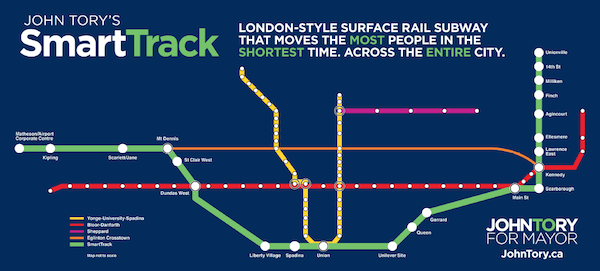Toronto mayoral race: Battle of the subways
Who has the best vision for public transit?
(J.P. Moczulski/Reuters)
Share

To the disappointment of journalists and late-night talk-show hosts everywhere, the Toronto mayoral election seems to have very little to do with crack videos and much to do with an issue of actual importance to the city — namely transit.
Having your own beautiful map of the future Toronto subway system has now become a prerequisite for being a frontrunner (or even a lesser known) candidate in this race. It’s likely the next mayor will be crowned on the basis of whether voters prefer his or her vision of subways, even more subways, or light rail.
So who has the best plan for ending gridlock and for convincing Torontonians that they should no longer snicker every time the TTC tries to call itself the Rocket? Here’s the rundown on the transit plans of the three main candidates:
Who: Rob Ford
What: Subways, Subways, Subways
Where: Scrap the planned light-rail transit from Don Mills to McCowan and replace it with a subway; connect the Sheppard subway line to the new Bloor-Danforth extension; move the planned above-ground portion of the Eglinton Crosstown from Laird to Kennedy underground; build a subway to connect Finch West Station to Humber College; build a relief line from Queen to Pape.
How long: 32 km
How much: $9 billion
Where’s the cash: Federal and provincial government contributions; money from the sale of city-owned real estate; development charges and assessment growth; public-private partnerships; sell “air rights” above the subway; tax-increment financing (see explanation under John Tory below); $2 billion in funding from the cancelled Sheppard and Finch light rail.
Who: John Tory
What: SmartTrack
Where: Aboveground subways from Pearson Airport south to Union Station and northeast to Markham; first project as part of Regional Express Rail (electrified GO trains.)
How long: 53 km
How much: $8 billion
Where’s the cash: $2.5 billion from the City of Toronto, funded over 30 years by tax-increment financing (taxes on new development along the subway line). The rest will need to come from the provincial and federal governments.
Who: Olivia Chow
What: Bike lanes and light rail
Where: Revive previously approved and provincially funded Scarborough rapid transit light rail and scrap subway plans; add new bus service; eventually build downtown relief subway line; build new bike lanes.
How long: Approximately 10 km of light rail and 200 km of bike lanes.
How much: Not fully explained, but around $2 billion. That includes $1.8 billion in existing provincial support for LRT projects, $15 million a year for buses and $9.5 million a year for bike lanes. A subway relief line would cost $8 billion but is not part of her platform for this term.
Where’s the cash: Raising land transfer taxes on homes over $2 million by one per cent, which will raise $20 million a year; borrow $1 billion; federal and provincial governments.


